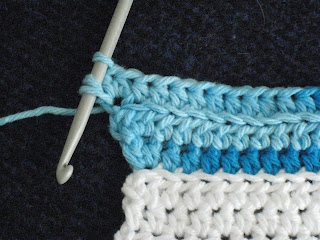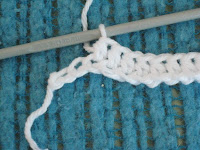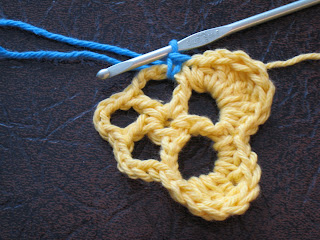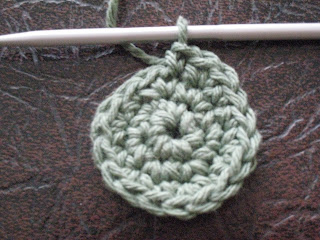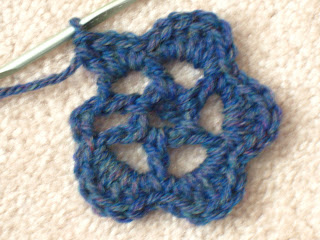It's taken a while for this post because I wasn't happy with the size of the potholder. It still didn't look right to me -- even with the changes I'd already made in converting a pattern for size 5 thread to one for worsted weight cotton yarn.
Here are the revised directions:
(The previous posts will be edited to reflect the changes.)
With white, ch 22
Row 1: skip 2, hdc 20, ch 2, turn (20 sts -- not counting the ch sts)
Row 2: Decrease 1 st at beginning of row, ch 2, turn (19 sts)
Row 3: Decrease 1 st at end of row, ch 2, turn (18 sts)
Row 4: Decrease 1 st at beginning of row, ch 2, turn (17 sts)
Row 5: Decrease 1 st at end of row. Break thread. (16 sts)
Attach new thread. (I used blue instead of peach.) Chain 2 to turn.
Work the rest through back loops only.
Row 6: Increase 1 st at beginning and 1 st at end of row, ch 2, turn (18 sts)
Row 7: Increase 1 st at beginning and 1 st at end of row, ch 2, turn (20 sts)
Row 8: Increase 1 st at beginning and 2 sts at end of row, ch 2, turn (23 sts)
Row 9: Increase 1 st at beginning and 1 st at end of row, ch 2, turn (25 sts)
Row 10: Increase 1 st at beginning and 1 st at end of row, ch 2, turn (27 sts)
Row 11: Increase 1 st at beginning and 2 sts at end of row, ch 2, turn (30 sts)
Row 12: Increase 2 sts at beginning and 1 st at end of row, ch 2, turn (33 sts)
Row 13: Increase 1 st at end of row, ch 2, turn (34 sts)
Row 14: Increase 1 st at beginning of row, ch 2, turn (35 sts)
Row 15: Work even, ch 2, turn (35 hdc sts)

Now to finish off the bonnet:
Row 16: Decrease 1 st at end of row, ch 2, turn (34 sts)
Row 17: Decrease 1 st at beginning and 1 st at end of row, ch 2, turn (32 sts)
Row 18: Decrease 1 st at beginning and 1 st at end of row, ch 2, turn (30 sts)
Row 19: Decrease 1 st at beginning and 1 st at end of row, ch 2, turn (28 sts)
-- or, in other words: Row 19: hdc 2tog, hdc 26, hdc 2 tog, ch2, turn (28 sts)-- hdc 2tog is "half double crochet 2 together" -- or, in other words, "decrease 1 st in hdc"The final 3 rows include sc (single crochet), dc (double crochet), hdc (half double crochet), and -- at the end of the last row, a slip stitch. So, I can't write "decrease 1", I need to write what stitch is used in the decrease.
These rows are a sizable departure from the original pattern. I wanted to keep the upturned brim of the hat (picture top right) from the original pattern. But, I also wanted a more rounded top for the middle of the bonnet.Row 20: dc 2tog, dc 2, hdc 1, sc 3, hdc 18, hdc 2tog, ch 2, turn (26 sts)
Row 21: hdc 2 tog, hdc 16, sc 3, hdc 1, dc 2, dc 2 tog, ch 2, turn (24 sts)
Row 22: dc 2 tog, dc 2, hdc 1, sc 3, hdc 4, dc 6, hdc 3, sc 2 tog, slip stitch to end row.
Pull yarn through. Weave in ends.
We're almost halfway done with the bonnet potholder. We still need to make a bonnet identical to the one just made. Then we can decorate them and crochet them together.
Index
 Next is an embellishment to make the potholder look more like a sunbonnet.
Next is an embellishment to make the potholder look more like a sunbonnet. Pick a spot 1 + 1/4" or more in from the front edge and where the white and blue meet. Put a hook through the bonnet and draw some yarn through. Put the hook through the bonnet again and draw yarn through the loop just made.
Pick a spot 1 + 1/4" or more in from the front edge and where the white and blue meet. Put a hook through the bonnet and draw some yarn through. Put the hook through the bonnet again and draw yarn through the loop just made. Continue in this manner until you reach the indentation at the top of the bonnet. I made 3 - 4 chain sts per 2 rows of crocheting.
Continue in this manner until you reach the indentation at the top of the bonnet. I made 3 - 4 chain sts per 2 rows of crocheting.


